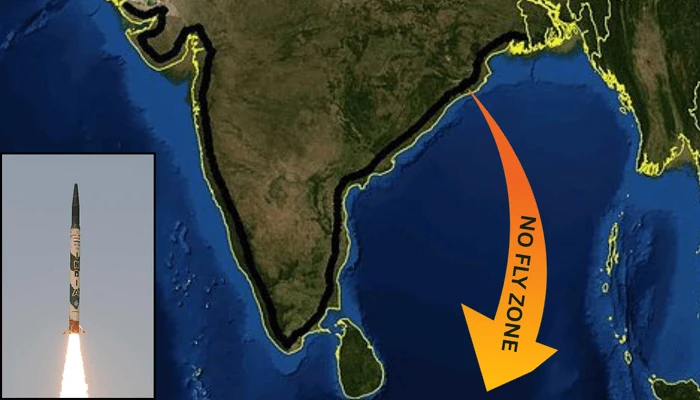India recently extended the Notice to Airmen (NOTAM) to 4,795 kms into the Indian Ocean for a missile test scheduled for 20-21 August.
The NOTAM warning issued by the Ministry of Defence extended the no-fly zone from the earlier 2530 kms range to now 4795 kms
The missile test will take place from the Integrated Test Range (ITR) on Dr APJ Abdul Kalam Island off the Odisha coast, in a major stride towards enhancing India’s strategic missile capabilities.
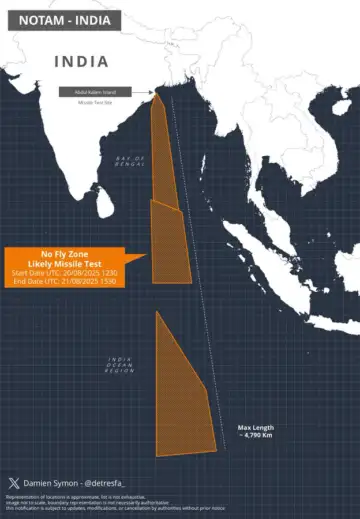 The move has fanned speculations that the test might involve the latest variant of the Agni series ballistic missiles. India has successfully tested five nuclear-capable ballistic missiles in the Agni series. People are guessing that Agni-VI could be test fired in the upcoming missile test later this month.
The move has fanned speculations that the test might involve the latest variant of the Agni series ballistic missiles. India has successfully tested five nuclear-capable ballistic missiles in the Agni series. People are guessing that Agni-VI could be test fired in the upcoming missile test later this month.
What is NOTAM
Notice to Airmen, or NOTAM, is an alert issued by an aviation or any other competent authority to aircraft pilots about a potential hazard or a danger zone on a flight route or in a location that could affect a flight. It contains advisories or essential information regarding an aeronautical facility, establishment, or flight route, which is important for aircraft operators to know to ensure the safe journey of a flight.
NOTAMs are issued in many cases, including those involving military conflicts between countries or a warning about a test-firing zone. NOTAM is also issued by a country when it wants to close its airspace for the aircraft of a certain country or countries. During the recent military hostilities between India and Pakistan, the countries issued NOTAMs about closing their airspaces for each other’s aircraft.
Notice to Airmen is generated and transmitted as per the guidelines of Aeronautical Information Services of the Convention on International Civil Aviation (CICA).
How DRDO secured the Dr Abdul Kalam Island for missile tests
Dr Abdul Kalam Island is located off the coast of Odisha, about 150 km from the state capital of Bhubaneswar. It forms a part of Odisha’s Bhadrak district. The island was earlier called Wheeler Island, after the English commandant Lieutenant Hugh Wheeler. In September 2015, the Odisha government renamed the island to pay tribute to the aerospace scientist and former President of India, Dr APJ Abdul Kalam. Dr Kalam is also known as the ‘Missile Man of India’ for his immense contribution to the development of India’s space and missile development programs.
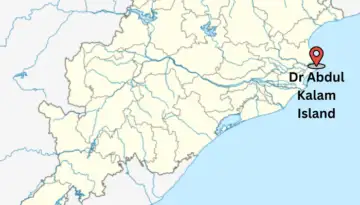 Image via Wikipedia
Image via Wikipedia
It is part of a group of five islands located in the Bay of Bengal, around 10 km from the eastern coast of India. The island has an area of about 390 acres and a length of about 2km. The nearest port to the island is Dhamra Port.
The island houses the Integrated Test Range missile testing facility of the Defence Research and Development Organisation (DRDO). Dr Kalam became its first director after its establishment in 1982. Most of India’s missiles, including Akash, Agni, Astra, BrahMos, Nirbhay, Prahaar, Orithvi, and Shaurya, have been test-fired from this facility. Besides, Advanced Air Defence, Prithvi Air Defence, SMART missiles and ASAT missiles were also tested here.
There is an interesting story about the establishment of the Integrated Test Range on the island. In the early 1980s, the government of India was looking for an appropriate location to build a dedicated military missile test range to start the development of Agni missiles. The DRDO was not able to conduct the tests at its desert range in Rajasthan owing to concerns about range safety and possible geopolitical issues. Andaman and Nicobar Islands were also not considered as a viable option because of their long distance from the mainland. The agency was looking for an uninhabited island closer to the mainland. That’s when Dr Kalam spotted three small islands named Long Wheeler, Coconut Wheeler and Small Wheeler near Dhamra’s coast.
Dr Kalam sent two scientists, Dr V. K. Saraswat and Dr S.K. Salwan, to find out the islands. The scientists set out on their mission to locate the islands. They reached Dhamra, where they hired a boat for ₹250. They entered the waters guided by a directional compass but got lost on their way. Fortunately, they came across some fishing vessels, and the fishermen, who had never heard of the Wheeler islands, guided them to a nearby island they referred to as “Chandrachood”. The scientists reached the “Chandrachood” island and figured out with the help of the map that it was Small Wheeler island. They spotted a Bangladeshi flag on the island, probably put up by Bangladeshi fishermen who visited the island. The scientists quickly removed the flag and, after checking the dimensions of the island, approved it for setting up a missile testing facility. However, they had to spend the night on the island, surviving only on bananas.
Later on, the DRDO received the clearance from the then Defence Minister P.V. Narasimha Rao and the Chief Minister of Odisha, who leased out the land to DRDO for 99 years. On November 30, 1993, the first missile test was conducted on the island, which was a successful test of the Prithvi missile. The missile test was conducted with greater accuracy than expected.
Since the construction of the Integrated Test Range, the entry of the general public has been restricted to the Abdul Kalam Island. Only DRDO personnel and the Defence Ministry officials are allowed to visit the island.
India’s nuclear-capable Agni Missiles
India’s Agni missile series comprises five long-range, nuclear-capable, surface-to-surface ballistic missiles. The missiles have ranges from medium to intercontinental. The first missile of the series, Agni I, was tested in 1989. It was developed under the Integrated Guided Missile Development Programme (IGMDP). After the successful testing of Agni I, it was separated from the IGMDP and designated as a special programme in the defence budget due to its strategic importance. The latest missile of the Agni series is Agni V, which was successfully test-fired in April 2012.
Here is an overview of the Agni family missiles developed so far by India:
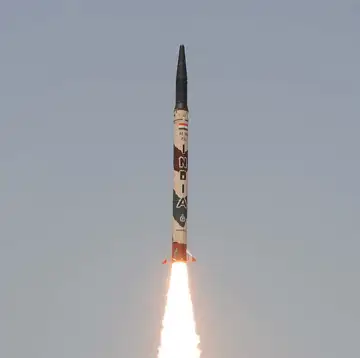 Agni-I, Image via Wikipedia
Agni-I, Image via Wikipedia
Agni I- It is a short-range ballistic missile with a range of 700-1200 km, which can be launched from a road-mobile launcher. It is equipped with advanced navigation, guidance, and control systems.
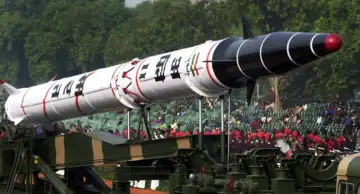 Agni-II, Image via The Hindu.
Agni-II, Image via The Hindu.
Agni II- It is a medium-range ballistic missile with a range of 2000-3500 km, capable of carrying both conventional and nuclear warheads. It is equipped with a ring laser gyro-based inertial navigation system.
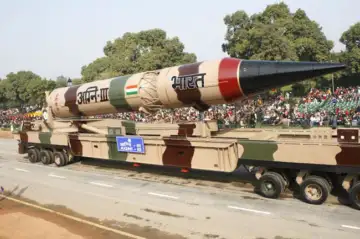 Agni-III, Image via missilethreat.csis.org
Agni-III, Image via missilethreat.csis.org
Agni III- It is an intermediate-range ballistic missile with a range of 3,000-5,000 km, which can be deployed from a road-mobile launcher. It has advanced on-board computer systems.
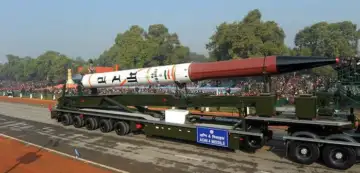 Agni-IV, Image via geopoliticalmonitor.
Agni-IV, Image via geopoliticalmonitor.
Agni IV- It is an intermediate-range ballistic missile with a range of 3,500-4,000 km. It can be launched using a road-mobile launcher. It carries composite rocket motors and a high-accuracy navigation system.
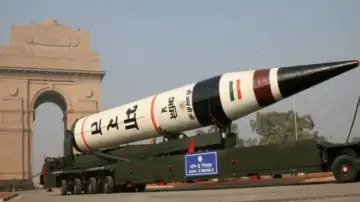 Agni-V missile (Image via defensexp.com)
Agni-V missile (Image via defensexp.com)
Agni V- It is an intercontinental ballistic missile (ICBM) with a range of 5,000-8,000 km. It has a range covering the entire Asia-Pacific region. It is equipped with MIRV (Multiple Independently Targetable Re-entry Vehicle) technology.
Agni VI- It is an intercontinental ballistic missile expected to have a range of 8,000-10,000 km with MIRVed warheads. It is in the early stages of development.
Agni-P (Prime)- It is a newer generation, road-mobile, two-stage solid-fuel missile with a range of 1,000-2,000 km. It is designed to have more agility and a shorter preparation time for launch. It is currently undergoing trials.
